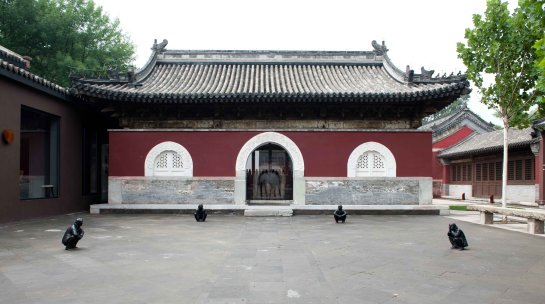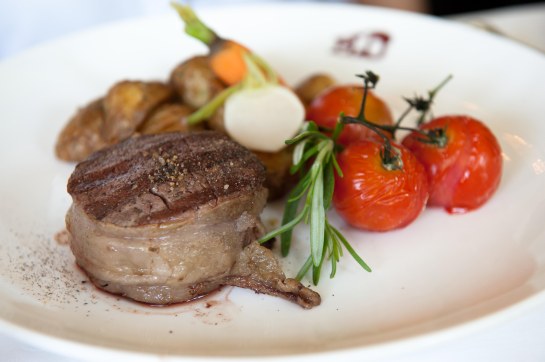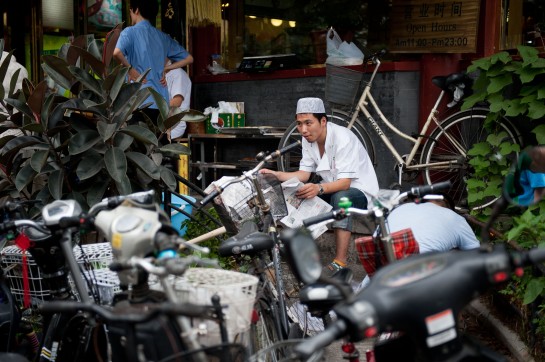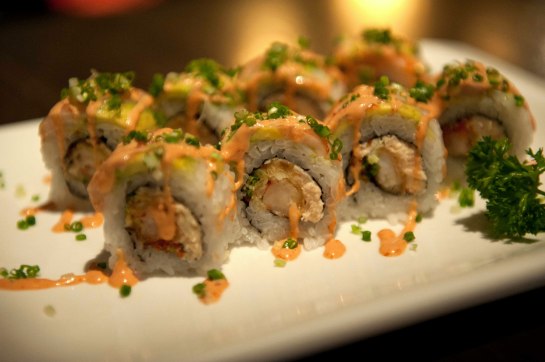TRB,Temple Restaurant Beijing
No. 23 Song Zhu Si, Shatan Beijie,
Dongcheng District. Beijing;
(86-10) 8400-2232;
temple-restaurant.com
Welcome to the Temple of Ohmmm-Nom (nomnomnom)
 Temple Restaurant Beijing is a showcase of two cities. The first is the old city, of a 600-year old temple that retains vestiges of its former architectural elegance, and of the bustling hutongs that surround its walled compound, a loud (and fragrant) reminder that lao Beijing is very much alive in a modernizing capital; The second is the new Beijing, of modern European cuisine served in a minimalist, grey-walled annex by a snappily suited Swiss intern from the Ecole Hôtelière de Lausanne.
Temple Restaurant Beijing is a showcase of two cities. The first is the old city, of a 600-year old temple that retains vestiges of its former architectural elegance, and of the bustling hutongs that surround its walled compound, a loud (and fragrant) reminder that lao Beijing is very much alive in a modernizing capital; The second is the new Beijing, of modern European cuisine served in a minimalist, grey-walled annex by a snappily suited Swiss intern from the Ecole Hôtelière de Lausanne.
The juxtaposition was not lost on us as we came ambling in from the stewing chaos of the hutongs outside. We are fans of eating at places with a story behind it, and as stories go, the Temple Restaurant one is pretty good, with a brilliantly renovated restaurant complex as embellishment. Ignace Lecleir, a former GM under Daniel Boulud and now owner of TRB, has created an oasis of calm befitting of the venue’s original purpose many years ago.
The fancifuls: Cheese balls and bread/butter

 There were flashes of brilliance in the lunch set meal (149 RMB) we had that day. The lobster mousse amuse-bouche was stunning in its depth of flavour. However, we encountered mixed fortunes with the starters.
There were flashes of brilliance in the lunch set meal (149 RMB) we had that day. The lobster mousse amuse-bouche was stunning in its depth of flavour. However, we encountered mixed fortunes with the starters.
Starters: Beef carpaccio and asparagus with quail’s egg

 The carpaccio was accompanied with a nifty a soya jelly cube to complement the meat’s rawness. The white asparagus with quail eggs was pleasant, but the flavours were somewhat open-ended.
The carpaccio was accompanied with a nifty a soya jelly cube to complement the meat’s rawness. The white asparagus with quail eggs was pleasant, but the flavours were somewhat open-ended.
The mains: Grilled red snapper on remoulade; Basil risotto

 As for the mains, the red snapper was competently grilled. As a matter of personal preference I didn’t agree with the remoulade that it was bedded on. The risotto came hot and moist, but too al-dente for our liking.
As for the mains, the red snapper was competently grilled. As a matter of personal preference I didn’t agree with the remoulade that it was bedded on. The risotto came hot and moist, but too al-dente for our liking.
For Desserts: Caramel tart and the ‘snow egg’ meringue that made Glen a little upset.

 The caramel tart ended the set in triumphant fashion. My only grouse was the misrepresentation of the “snow-egg” dessert. No matter how you bandy it about, half-cooked meringue just doesn’t taste that good. Our personal preferences aside, TRB provides possibly the best value lunch set in Beijing right now.
The caramel tart ended the set in triumphant fashion. My only grouse was the misrepresentation of the “snow-egg” dessert. No matter how you bandy it about, half-cooked meringue just doesn’t taste that good. Our personal preferences aside, TRB provides possibly the best value lunch set in Beijing right now.
A nifty touch: home made scented marshmallows
 We enjoyed TRB immensely, but as we ruminate over this entry, we get the feeling its story is not complete. Ignace Lecleir has done a fantastic job in importing the brand of French dining he knows so well to Beijing, and his team didn’t put a foot wrong when we were there. The service of this restaurant would easily be on par with one-star Michelin restaurants anywhere in the world. This gastronomic fable could have been better climaxed with a menu that showcased a heavier Chinese influence. Places like Lung King Heen (Hong Kong) and Hakkasan (London) have shown that Chinese cooking is viable at the highest level of fine-dining standards, and we can’t think of a better place to have it served than in the eclectic interior of the Temple Restaurant.
We enjoyed TRB immensely, but as we ruminate over this entry, we get the feeling its story is not complete. Ignace Lecleir has done a fantastic job in importing the brand of French dining he knows so well to Beijing, and his team didn’t put a foot wrong when we were there. The service of this restaurant would easily be on par with one-star Michelin restaurants anywhere in the world. This gastronomic fable could have been better climaxed with a menu that showcased a heavier Chinese influence. Places like Lung King Heen (Hong Kong) and Hakkasan (London) have shown that Chinese cooking is viable at the highest level of fine-dining standards, and we can’t think of a better place to have it served than in the eclectic interior of the Temple Restaurant.
And, here’s a little collage of us enjoying the meal! Glen’s face reads “Gloria is holding my camera the wrong way again…” :O





















 We’d like to tell you about a special place called Kagen. It’s the place where Gloria made her only exception to her general dislike for Hot Pot/Steamboat. At Kagen, they have taken this longstanding method of communal eating and updated it a little.
We’d like to tell you about a special place called Kagen. It’s the place where Gloria made her only exception to her general dislike for Hot Pot/Steamboat. At Kagen, they have taken this longstanding method of communal eating and updated it a little. For starters, Kagen’s soup stocks are things of beauty. Each of the 6 soups is balanced to complement your dipping ingredients in their own special way. If you’re having a meat-dominated hotpot, go for the chicken and mushroom or the miso stock. Those are our favourites.
For starters, Kagen’s soup stocks are things of beauty. Each of the 6 soups is balanced to complement your dipping ingredients in their own special way. If you’re having a meat-dominated hotpot, go for the chicken and mushroom or the miso stock. Those are our favourites. Diners also get a customizable dipping sauce. A sauce-mobile will be wheeled up for you to choose from a range of 4 sauces and 8 condiments. Once again, depending on what you’re having with your hotpot, the waitress will recommend different combinations for your meats or seafood. The regular sesame paste is your sauce for all occasions, and the aptly named seafood paste (a kind of XO-dipping sauce familiar to Singaporeans and Malaysians) goes well with (whatd’yaknow!) seafood. The sweet-and-sourish yuzu fruit vinegar was a surprise package, and also Gloria’s favourite. Best served with a healthy tablespoonful of coriander and fried garlic.
Diners also get a customizable dipping sauce. A sauce-mobile will be wheeled up for you to choose from a range of 4 sauces and 8 condiments. Once again, depending on what you’re having with your hotpot, the waitress will recommend different combinations for your meats or seafood. The regular sesame paste is your sauce for all occasions, and the aptly named seafood paste (a kind of XO-dipping sauce familiar to Singaporeans and Malaysians) goes well with (whatd’yaknow!) seafood. The sweet-and-sourish yuzu fruit vinegar was a surprise package, and also Gloria’s favourite. Best served with a healthy tablespoonful of coriander and fried garlic. Lastly, Kagen’s really good for lazy eaters. Hotpot is a very hands-on, involved activity, and sometimes it’s nice to be able to enjoy the food without the toil. There was always a helper handy to put stuff into the pot for us, giving Gloria and I more time to talk and catch up on life.
Lastly, Kagen’s really good for lazy eaters. Hotpot is a very hands-on, involved activity, and sometimes it’s nice to be able to enjoy the food without the toil. There was always a helper handy to put stuff into the pot for us, giving Gloria and I more time to talk and catch up on life.







 Temple Restaurant Beijing is a showcase of two cities. The first is the old city, of a 600-year old temple that retains vestiges of its former architectural elegance, and of the bustling hutongs that surround its walled compound, a loud (and fragrant) reminder that lao Beijing is very much alive in a modernizing capital; The second is the new Beijing, of modern European cuisine served in a minimalist, grey-walled annex by a snappily suited Swiss intern from the Ecole Hôtelière de Lausanne.
Temple Restaurant Beijing is a showcase of two cities. The first is the old city, of a 600-year old temple that retains vestiges of its former architectural elegance, and of the bustling hutongs that surround its walled compound, a loud (and fragrant) reminder that lao Beijing is very much alive in a modernizing capital; The second is the new Beijing, of modern European cuisine served in a minimalist, grey-walled annex by a snappily suited Swiss intern from the Ecole Hôtelière de Lausanne. 


 The carpaccio was accompanied with a nifty a soya jelly cube to complement the meat’s rawness. The white asparagus with quail eggs was pleasant, but the flavours were somewhat open-ended.
The carpaccio was accompanied with a nifty a soya jelly cube to complement the meat’s rawness. The white asparagus with quail eggs was pleasant, but the flavours were somewhat open-ended.
 As for the mains, the red snapper was competently grilled. As a matter of personal preference I didn’t agree with the remoulade that it was bedded on. The risotto came hot and moist, but too al-dente for our liking.
As for the mains, the red snapper was competently grilled. As a matter of personal preference I didn’t agree with the remoulade that it was bedded on. The risotto came hot and moist, but too al-dente for our liking.
 The caramel tart ended the set in triumphant fashion. My only grouse was the misrepresentation of the “snow-egg” dessert. No matter how you bandy it about, half-cooked meringue just doesn’t taste that good. Our personal preferences aside, TRB provides possibly the best value lunch set in Beijing right now.
The caramel tart ended the set in triumphant fashion. My only grouse was the misrepresentation of the “snow-egg” dessert. No matter how you bandy it about, half-cooked meringue just doesn’t taste that good. Our personal preferences aside, TRB provides possibly the best value lunch set in Beijing right now.

 We strive to be as objective as we can about our food, so we really do mean it when we say that Hatsune in Beijing is possibly our favourite restaurant in the world right now. We first dined at Hatsune in 2010, when we visited Beijing enroute to the Shanghai Expo, and going back this time round was a bit like making a pilgrimage to Japanese-fusion Mecca.
We strive to be as objective as we can about our food, so we really do mean it when we say that Hatsune in Beijing is possibly our favourite restaurant in the world right now. We first dined at Hatsune in 2010, when we visited Beijing enroute to the Shanghai Expo, and going back this time round was a bit like making a pilgrimage to Japanese-fusion Mecca. To describe it simply, Hatsune is a Japanese-fusion restaurant that serves new and gastronomically exciting rolls. They have the usual selection of Japanese-y food like sashimi, tempura, and donburi sets to give off the impression that you really are eating in a Japanese restaurant. When we talk about the rolls however, it behooves us to reject the traditional frame of reference of assessing Japanese food and move towards a new rubric. Japanese cuisine is conservative, perfectionist and traditional; Hatsune rolls are creative, decadent and use far too much mayonnaise for your dietician’s liking. They still taste pretty darn good, and have become our world-standard of how similar rolls should taste.
To describe it simply, Hatsune is a Japanese-fusion restaurant that serves new and gastronomically exciting rolls. They have the usual selection of Japanese-y food like sashimi, tempura, and donburi sets to give off the impression that you really are eating in a Japanese restaurant. When we talk about the rolls however, it behooves us to reject the traditional frame of reference of assessing Japanese food and move towards a new rubric. Japanese cuisine is conservative, perfectionist and traditional; Hatsune rolls are creative, decadent and use far too much mayonnaise for your dietician’s liking. They still taste pretty darn good, and have become our world-standard of how similar rolls should taste.









